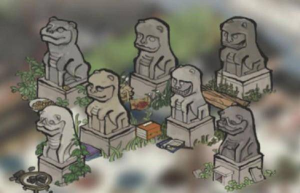It is said that there was a stone tiger on Tiger Hill, and every spring it would come down the hill to terrorize people along Shantang Street. One year, an old man came and claimed that he could subdue the stone tiger. He hired seven skilled stonemasons to create seven lifelike stone cats placed along Shantang Street and each facing toward Tiger Hill. When the stone tiger came down from the mountain again, it was scared by the stone cats and fled away. It never returned to Shantang Street again. The old man’s strategy was to use the fierce nature of the cats, which is pronounced similarly to the word “li” (里) meaning “mile.” The old man’s success in subduing the stone tiger is why Shantang Street is now referred to as “Seven Li (cat) Shantang,” or “Seven-Mile Shantang.”
–Story adapted from “七狸”山塘街, Cultural Suzhou Website. link

Humans have an innate desire to learn about places and cultures different from their own. Stories and legends are an excellent way to learn about a place as they give insights into its history and culture behind. However, these stories and legends are often disregarded, and their importance is not fully appreciated until they are rediscovered nowadays.
The story of Shantang Street and the seven cats is a good example of this. The street is known for its traditional architecture, delicious local food, and cultural significance. However, it was not until the last decade that the story of the seven cats was known by tourists, though this story has now become synonymous with the street. This phenomenon is not unique to Shantang Street or even to China. Many places around the world have folktales that are either forgotten or overlooked, which may result in a loss of cultural heritage.

The splitting-water cat. 分水狸
It is important to recognize these stories in the everchanging world, where globalization and homogenization threaten to erase the uniqueness of different cultures. It is unfortunate that sometimes cultural heritage is overlooked, but it is great to see that people are now becoming more aware and appreciative of their cultural traditions. By promoting those legends, we not only preserve cultural heritage, but also provide opportunities for people to learn about other cultures and bring economic benefits to the community. This, in turn, fosters respect between cultures and contributes to a more harmonious world.
The story of the seven cats shows how promoting cultural heritage can have positive economic and social impacts. Since the story’s promotion, Shantang Street has become more popular among domestic and foreign visitors. The seven cats, as the unique cultural symbol, is going to make ancient scenic spots more vital in the days to come. In conclusion, stories and legends are valuable tools for learning about places and cultures, though they are easily forgotten. And hence, it is crucial to recognize and promote them to preserve cultural heritage, which enhances greater appreciation between cultures and brings socio-economic benefits as well.

Finding the seven cats along Shantang Street
